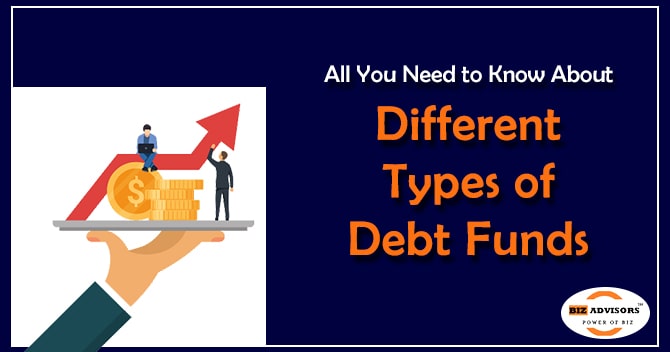Debt is a major market where people make a profit by investing their hard-earned money. Debt funds are also called as bond funds or fixed-income funds. It is an investment in bonds or debt securities. Debt funds invest a significant portion of the money in securities that generate fixed-income such as government securities, debentures, corporate bonds and various other money-market instruments. Such investing lowers the risk for investors for it is known for being a stable investment platform to generate wealth. This article aims to look at what are debt funds and explain the different types of debt funds and their benefits.
How do different types of Debt Funds work?
Each debt security has a credit rating that allows investors to understand that the debt issuer may fail to pay principal and interest. Debt fund managers use these ratings to select high-quality fixed income. The higher the rating, the less likely the publisher will default.
What are the benefits of debt funds?
Debt funds are not affected by market volatility, making them one of the best investment options available to protect against volatile and unpredictable market events. The benefits of investing in debt funds are as follows:-
- Offers better returns than savings and bank loans,
- Low risk and high stability,
- Suitable for new investors who wish to not take high risks,
- Investment can be redeemed whenever needed to make it liquid securities and
- It is the best option to reach your investment goals with stable returns for a limited time
Who should invest in Debt Mutual Fund?
Those investors who want to go for lower risk are recommended to go for debt funds. It is ideal for low risk investors because the debt funds are allotted based on securities which ensure stable returns. Investors are of two types and they are following:-
- Short-term investors:- These investors take up debt funds for 3-12 months
- Medium-term investors: These investors invest for debt funds for about 3-5 years
Types of Debt Funds
The debt funds are classified into the following types based on the maturity period:-
- Liquid Fund
This type of investment is for a maximum of 91 days. It provides better returns than savings accounts and it is good for short-term investments. This fund can be easily converted into cash because of its low maturity period and stable returns. This investment is made in Treasury Bills or Certificate of Deposit[1].
- Money Market Fund
Debt funds investment is done for maximum maturity of 1 year. These funds are good for those who are seeking low-risk for a short-term.
- Dynamic Bond Fund
A person invests in this type of debt instrument for its moderate risk tolerance and an investment maturity of 3 to 5 years. The fund manager of these debt funds keeps changing the fund’s composition according to changing interest rates.
- Corporate Bond Fund
The investor shall invest a minimum of 80% of its total assets in corporate bonds which has the highest ratings. These funds are good for those who prefer lower risk and invest in high-quality corporate bonds. It is also apt for those who are looking for regular income and safety of principal.
- Banking and PSU Fund
In this type of debt funds, the investor will invest at least 80% of its total assets in debt securities of the Public Sector Undertakings, banks, and public financial institutions. The risk factor is moderate which prefers balance yield, safety, and liquidity.
- Gilt Fund
There is no credit risk factor because these are government-issued debt funds but the interest rate risk is high. Gilt debt funds investment is done in securities issued by central and state governments. The maturity period is between medium to long-term. This is suitable for those who wish to invest in the long term.
- Credit Risk Fund
This type of funds invests a minimum of 65% of the total assets in corporate bonds. These funds have credit risk but it provides better returns.
- Floater Fund
Floater Funds invest at 65% of their assets in floating-rate bonds. These funds have a low interest-rate risk.
- Overnight Fund
This type of debt fund invests in debt securities having a maturity of 1 day. They are extremely safe, with zero credit risk and interest rate risk. It is preferable for those who wish to park their funds for a short period.
- Ultra-Short Duration Fund
It is suitable for investors who wish to invest for a maturity period of 3 months. This provides slight higher yields than liquid funds. It has a low-risk factor.
- Low Duration Fund
They are risky and provide only reasonable returns. The maturity period for this type of debt fund is 6 months to 12 months.
- Short Duration Fund and Ultra Short-term Funds
The maturity period for a short duration type of debt funds is 1-3 years. It functions best when the interest rates are high. It provides a higher return than liquid funds. Ultra short-term funds are provided often to companies for a duration of 3 to 6 months. Since the duration period is less, there are slight chances of risk than liquid funds.
- Medium, Medium to Long and Long Duration Funds
The maturity period of medium duration fund is between 3-4 years, medium-to-long duration fund between 4-7 years, and long duration funds are more than 7 years. These funds invest in securities of the Government, public sector, and private sector companies. When the interest rates are falling, the funds tend to do better and when the interest rates are rising, they tend to fail. Hence, this type of funds has a high-interest rate.
Conclusion
For the purposes of debt fund investment, it is necessary for investors to look into the various types of debt funds and choose according to their liking based on the risk factors, the returns, maturity period, tax on returns, etc. This helps the investor in generating more income without any loss in a safe manner.
Read our article:A Complete Guide on Foreign Direct Investment Compliance under FEMA
 9559179325
9559179325 9559179325
9559179325





